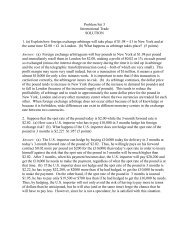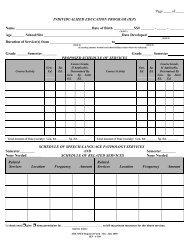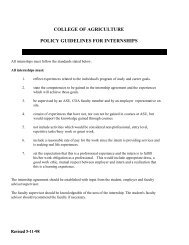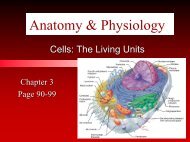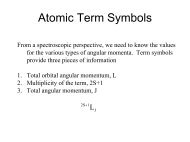Introduction to Optimization Introduction to Optimization
Introduction to Optimization Introduction to Optimization
Introduction to Optimization Introduction to Optimization
- No tags were found...
You also want an ePaper? Increase the reach of your titles
YUMPU automatically turns print PDFs into web optimized ePapers that Google loves.
This chapter provides an introduction <strong>to</strong> optimization models and solution approaches.<strong>Optimization</strong> is a major field within the discipline of management science.The emphasis is on developing appropriate mathematical models <strong>to</strong> describe situations,implementing these models in a spreadsheet, using a spreadsheet-based solver<strong>to</strong> solve the optimization problems, and using human intelligence and judgment <strong>to</strong>interpret the results. We emphasize a particular type of optimization problem, calledlinear programming problems (or linear optimization). In linear programming (LP)problems, all of the relationships among the variables are linear.Think briefly about the allocation of study time mentioned in the opening paragraphs.In an optimization mindset, there is an objective you want <strong>to</strong> either maximizeor minimize, and there may be constraints within which you need <strong>to</strong> operate. Thereare also specific quantities, called decision variables, over which you have control.Therefore, this is termed a constrained optimization problem. A verbal statement ofthe study time problem might be that you want <strong>to</strong> maximize your grade point average.Constraints are a limited <strong>to</strong>tal amount of time <strong>to</strong> study and a desire <strong>to</strong> pass everycourse. Decision variables are the amounts of time allocated <strong>to</strong> each course. A morestructured statement of the problem isMaximize the objective: Grade point averageSubject <strong>to</strong> the constraints: Stay within available study timePass each course with a grade of at least CDecision variables: Amount of time <strong>to</strong> spend on each courseOur purpose is not <strong>to</strong> develop a formal mathematical model of the study time example.However, the actual process of thinking about a problem in a structured wayoften leads <strong>to</strong> insights you can use <strong>to</strong> make a better decision. You would probably thinkabout your current grade in each course, the remaining requirements of the course,and the amount of study time needed in order <strong>to</strong> at least pass each course. You mightalso think about how much time you would need <strong>to</strong> spend in order <strong>to</strong> get the best possiblegrade in each course. This structured thinking often leads <strong>to</strong> a better overall deciancmat02.qxd11/16/06 3:25 PM Page B2B2 • SUPPLEMENT BINTRODUCTION TO OPTIMIZATIONEveryone, almost daily, solves optimization problems in informal ways by usingmental models. If you have ever looked at a map when planning a trip and decidedupon a route <strong>to</strong> your destination <strong>to</strong> try <strong>to</strong> minimize either distance or time (or even <strong>to</strong>maximize scenic or recreational benefits), you have solved an optimization problem. Ifyou have ever been faced with <strong>to</strong>o much school work (i.e., studying for final examsand completing final projects) and a fixed amount of time, you have undoubtedlysolved an optimization problem that seeks <strong>to</strong> allocate the time available so that youwould, perhaps, maximize your grades in the various courses.Whereas informal optimization is done nearly every day by individuals, organizationscarry out formal optimization <strong>to</strong> assist in such decisions as product mix, pricing,scheduling, routing and logistics, supply chain management, facility location analysis,and financial planning and asset management. Many of these <strong>to</strong>pics are either directlyrelated <strong>to</strong> operations management or have strong connections <strong>to</strong> it. <strong>Optimization</strong> as adecision support <strong>to</strong>ol has applications across all functional areas of an organization.INTRODUCTION ObjectiveThe quantity <strong>to</strong> bemaximized or minimized. ConstraintsLimitations or requirementsthat must be satisfied. Decision variablesQuantities under the controlof the decision maker. Constrained optimizationproblemA mathematical modelin which one is trying <strong>to</strong>maximize or minimize somequantity, while satisfying aset of constraints.






